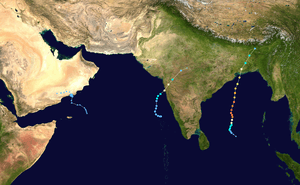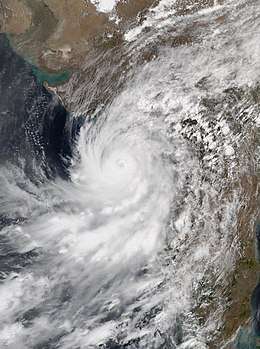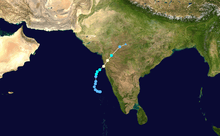2020 North Indian Ocean cyclone season
The 2020 North Indian Ocean cyclone season is an ongoing event in the annual cycle of tropical cyclone formation. The North Indian Ocean cyclone season has no official bounds, but cyclones tend to form between April and November, with peaks in May and October. These dates conventionally delimit the period of each year when most tropical cyclones form in the northern Indian Ocean. The season began on May 16 with the designation of Depression BOB 01 in the Bay of Bengal, later to become Super Cyclonic Storm Amphan, one of the strongest storms in the bay recorded and the costliest storm on record in the basin.
| 2020 North Indian Ocean cyclone season | |
|---|---|
 Season summary map | |
| Seasonal boundaries | |
| First system formed | May 16, 2020 |
| Last system dissipated | Season ongoing |
| Strongest storm | |
| Name | Amphan |
| • Maximum winds | 240 km/h (150 mph) (3-minute sustained) |
| • Lowest pressure | 920 hPa (mbar) |
| Seasonal statistics | |
| Depressions | 3 |
| Deep depressions | 2 |
| Cyclonic storms | 2 |
| Severe cyclonic storms | 2 |
| Very severe cyclonic storms | 1 |
| Extremely severe cyclonic storms | 1 |
| Super cyclonic storms | 1 (record high, tied with 1977, 1989, 1990, 1991, 1999, 2007 and 2019) |
| Total fatalities | 137 total |
| Total damage | > $14.265 billion (2020 USD) (Second-costliest North Indian Ocean cyclone season on record) |
| Related articles | |
The scope of this article is limited to the Indian Ocean in the Northern Hemisphere, east of the Horn of Africa and west of the Malay Peninsula. There are two main seas in the North Indian Ocean — the Arabian Sea to the west of the Indian subcontinent, abbreviated ARB by the India Meteorological Department (IMD); and the Bay of Bengal to the east, abbreviated BOB by the IMD.
The official Regional Specialized Meteorological Centre in this basin is the India Meteorological Department (IMD), while the Joint Typhoon Warning Center releases unofficial advisories. On average, three to four cyclonic storms form in this basin every season.[1]
Season summary

Systems
Super Cyclonic Storm Amphan
| Super cyclonic storm (IMD) | |
| Category 5 tropical cyclone (SSHWS) | |
  | |
| Duration | May 16 – May 20 |
|---|---|
| Peak intensity | 240 km/h (150 mph) (3-min) 920 hPa (mbar) |
At 00:00 UTC on May 16, a depression formed in the southeast Bay of Bengal and was identified as BOB 01. Six hours later, the Indian Meteorological Department (IMD) upgraded the system to a deep depression. The system began bringing torrential rainfall to Sri Lanka and Southern India. Around 15:00 UTC, the system further developed into Cyclonic Storm Amphan.[2][3] That morning, landslide and flooding warnings were hoisted for parts of eastern Sri Lanka and the Indian state of Kerala were given expectations of torrential rainfall in the coming days.[4] By 09:00 UTC of May 17, Amphan had intensified into a very severe cyclonic storm. Within 12 hours, the storm had developed an eye and started to rapidly intensify, becoming an extremely severe cyclonic storm. According to the JTWC, it explosively intensified from a Category 1-equivalent cyclone to a Category 4-equivalent cyclone in just 6 hours. The following morning around 10:30 UTC, the IMD upgraded Amphan to a super cyclonic storm with 3-minute sustained winds of 240 km/h (150 mph) and a minimum pressure of 920 hPa (27.46 inHg). This marked the second year in a row featuring a super cyclonic storm, the previous year seeing Kyarr in the Arabian Sea. On May 20, at approximately 17:30 IST, the cyclone made landfall near Bakkhali, West Bengal after weakening subsequently. It rapidly weakend once inland, and dissipated on the next day. It left behind a trail of catastrophic damage, and was later confirmed to be the costliest storm ever in the basin.
Depression ARB 01
| Depression (IMD) | |
  | |
| Duration | May 29 – May 31 |
|---|---|
| Peak intensity | 45 km/h (30 mph) (3-min) 1000 hPa (mbar) |
A depression formed overland near Salalah, Oman on May 29.
The Public Authority for Civil Aviation (PACA) in Oman advised residents to exercise caution and not to venture to low-lying areas or sea. The Supreme Committee asked people to remain at home in non-emergency circumstances.[5] The hospital in Sadah was evacuated as the depression intensified.[6] Over 200 mm (7.9 in) of rain fell in Dhofar Governorate on May 29;[7] some areas received the equivalent of two years of rainfall.[8] The highest precipitation total was measured in Mirbat, where 1,055 mm (41.5 in) of rain fell.[9] Two days of heavy rainfall, accumulating to 260 mm (10 in), caused floods in Salalah.[10] Operations at the port of Salalah were interrupted by the tropical depression.[11] Residents in central Salalah experienced disruptions to power and water services. Military police were dispatched to clear roads and airlift people marooned by the floods.[12] Engineering teams from the Ministry of Defence were deployed to restore utilities and render air where necessary.[13] Two people were found dead in a wadi due to flash floods,[14] while another person died and three were injured when a building collapsed.[8] More than 50 people were rescued from floods.[15]
Severe Cyclonic Storm Nisarga
| Severe cyclonic storm (IMD) | |
| Category 1 tropical cyclone (SSHWS) | |
  | |
| Duration | June 1 – June 4 |
|---|---|
| Peak intensity | 110 km/h (70 mph) (3-min) 990 hPa (mbar) |
During May 31, an area of low pressure developed over the south-eastern Arabian Sea and remained as a well marked low pressure area over the same region until the evening. It strengthened into a depression over the east-central and south-east Arabian Sea in the early morning of June 1 when it was centered about 340 km south-west of Goa, 630 km south-southwest of Mumbai and 850 km south-southwest of Gujarat. On June 2, around noon, the prevailing deep depression intensified into a cyclonic storm thereby receiving the name Nisarga. Nisarga intensified into a severe cyclonic storm before making landfall near the coastal town of Alibag in Maharashtra at 12:30 (IST) on June 3. The cyclone subsequently weakened into a deep depression by June 4.[16]
Storm names
Within this basin, a tropical cyclone is assigned a name when it is judged to have reached cyclonic storm intensity with winds of 65 km/h (40 mph). The names were selected by members of the ESCAP/WMO panel on Tropical Cyclones between 2000 and May 2004, before the Regional Specialized Meteorological Center in New Delhi started to assign names in September 2004. There is no retirement of tropical cyclone names in this basin as the list of names is only scheduled to be used once before a new list of names is drawn up. Should a named tropical cyclone move into the basin from the Western Pacific, then it will retain its original name. The next eight names from the list of North Indian Ocean storm names are listed below. Amphan is the last name from the original naming list published in 2004, while Nisarga is the first name from the new naming list published in 2020.
|
Season effects
This is a table of all storms in the 2020 North Indian Ocean cyclone season. It mentions all of the season's storms and their names, duration, peak intensities (according to the IMD storm scale), damage, and death totals. Damage and death totals include the damage and deaths caused when that storm was a precursor wave or extratropical low, and all of the damage figures are in 2020 USD.
| Name | Dates active | Peak classification | Sustained wind speeds |
Pressure | Areas affected | Damage (USD) |
Deaths | Refs |
|---|---|---|---|---|---|---|---|---|
| Amphan | May 16 – 21 | Super cyclonic storm | 240 km/h (150 mph) | 920 hPa (27.17 inHg) | Sri Lanka, India, Bangladesh, Bhutan | $13.6 billion | 128 | [17] |
| ARB 01 | May 29 – 31 | Depression | 45 km/h (30 mph) | 1000 hPa (29.53 inHg) | Oman, Yemen | Unknown | 3 | |
| Nisarga | June 1 – 4 | Severe cyclonic storm | 110 km/h (70 mph) | 990 hPa (29.23 inHg) | West India | $665 million | 6 | [18] |
| Season aggregates | ||||||||
| 3 systems | May 16 – Season ongoing | 240 km/h (150 mph) | 920 hPa (27.17 inHg) | $14.3 billion | 137 | |||
See also
- Tropical cyclones in 2020
- North Indian Ocean cyclone season
- 2020 Atlantic hurricane season
- 2020 Pacific hurricane season
- 2020 Pacific typhoon season
- South-West Indian Ocean cyclone seasons: 2019–20, 2020–21
- Australian region cyclone seasons: 2019–20, 2020–21
- South Pacific cyclone seasons: 2019–20, 2020–21
References
- "Annual Frequency of Cyclonic Disturbances (Maximum Wind Speed of 17 Knots or More), Cyclones (34 Knots or More) and Severe Cyclones (48 Knots or More) Over the Bay of Bengal (BOB), Arabian Sea (AS) and Land Surface of India" (PDF). India Meteorological Department. Retrieved 30 October 2015.
- "RSMC TROPICAL CYCLONE ADVISORY BULLETIN" (PDF). Regional Specialised Metrological Center. Retrieved 17 May 2020.
- "Cyclone Amphan Live Update: SuCS Moving Away From Odisha Coast". Odisha Television. 20 May 2020. Retrieved May 20, 2020.
- "Cyclone Amphan warning issued in India and Sri Lanka One person has died and a woman has gone missing as rains lash Sri Lanka". 16 May 2020. Retrieved 17 May 2020.
- "Low pressure system 200km away from Oman coast". Times of Oman. Muscat, Oman: Muscat Media Group. May 28, 2020. Retrieved May 29, 2020.
- "Sadah Hospital evacuated as centre of tropical depression moves towards Dhofar". Times of Oman. Muscat, Oman: Muscat Media Group. May 29, 2020. Retrieved May 29, 2020.
- "Heavy rains, strong winds may continue in Dhofar until tomorrow: PACA official". Times of Oman. Muscat, Oman: Muscat Media Group. May 29, 2020. Retrieved May 29, 2020.
- Nasrallah, Tawfiq (May 30, 2020). "Three people die due to heavy rains in Oman". Gulf News. Dubai, United Arab Emirates: Gulfnews.com. Retrieved May 31, 2020.
- "Rainfall amounts in Oman exceed 2018 cyclone Mekunu". Times of Oman. Muscat, Oman: Muscat Media Group. June 2, 2020. Retrieved June 2, 2020.
- McElwee, Ro (May 30, 2020). "Two days of rain have revived the roar of waterfalls in Salalah". Al Jazeera. Al Jazeera Media Network. Retrieved May 30, 2020.
- "Operations at Salalah port suspended". Times of Oman. Muscat, Oman: Muscat Media Group. May 30, 2020. Retrieved May 30, 2020.
- "Oman floods leave one dead in southern city of Salalah". The National. The National. May 30, 2020. Retrieved May 30, 2020.
- "Tropical depression: Oman's defence ministry teams provide assistance". Times of Oman. Muscat, Oman: Muscat Media Group. June 2, 2020. Retrieved June 2, 2020.
- "Two dead as Dhofar witnesses heavy rain and flooding". Times of Oman. Muscat, Oman: Muscat Media Group. May 30, 2020. Retrieved May 30, 2020.
- "Dhofar rescue teams rise to the challenge". Times of Oman. Salalah, Oman: Muscat Media Group. May 31, 2020. Retrieved May 31, 2020.
- "Highlights: Cyclone Weakened, May Enter Madhya Pradesh From Its Southern Parts, Says Weather Department". NDTV.com. Retrieved 2020-06-06.
- "Adverse weather claims two lives". Sunday Observer. 17 May 2020. Retrieved 17 May 2020.
- Srivastava, Ritesh (4 June 2020). "Maharashtra Cyclone Nisarga death toll rises to 6, CM announces Rs 4 lakh compensation for victims' kin". Zee News. Retrieved 5 June 2020.
External links
| Wikimedia Commons has media related to 2020 North Indian Ocean cyclone season. |